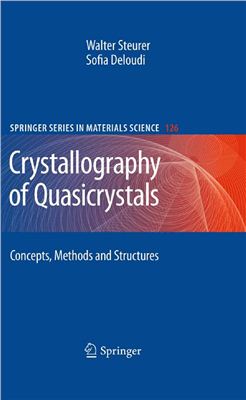Springer-Verlag, Berlin, 2009, 384 pages
From tilings to quasicrystal structures and from surfaces to the n-dimensional approach, this book gives a full, self-contained in-depth description of the crystallography of quasicrystals. It aims not only at conveying the concepts and a precise picture of the structures of quasicrystals, but it also enables the interested reader to enter the field of quasicrystal structure analysis. Going beyond metallic quasicrystals, it also describes the new, dynamically growing field of photonic quasicrystals. The readership will be graduate students and researchers in crystallography, solid-state physics, materials science, solid- state chemistry and applied mathematics.
The book consists of three parts. The part Concepts treats the properties of tilings and coverings. If decorated by polyhedral clusters, these can be used as models for quasiperiodic structures. The higher-dimensional approach, central to the crystallography of quasicrystals, is also in the center of this part.
The part Methods discusses experimental techniques for the study of real quasicrystals as well as power and limits of methods for their structural analysis. What can we know about a quasicrystal structure and what do we want to know, why, and what for, this is the guideline.
The part Structures presents examples of quasicrystal structures, followed by a discussion of phase stability and transformations from a microscopical point of view. It ends with a chapter on soft quasicrystals and artificially fabricated macroscopic structures that can be used as photonic or phononic
quasicrystals.
This book is intended for researchers in the field of quasicrystals and all scientists and graduate students who are interested in the crystallography of quasicrystals.
From tilings to quasicrystal structures and from surfaces to the n-dimensional approach, this book gives a full, self-contained in-depth description of the crystallography of quasicrystals. It aims not only at conveying the concepts and a precise picture of the structures of quasicrystals, but it also enables the interested reader to enter the field of quasicrystal structure analysis. Going beyond metallic quasicrystals, it also describes the new, dynamically growing field of photonic quasicrystals. The readership will be graduate students and researchers in crystallography, solid-state physics, materials science, solid- state chemistry and applied mathematics.
The book consists of three parts. The part Concepts treats the properties of tilings and coverings. If decorated by polyhedral clusters, these can be used as models for quasiperiodic structures. The higher-dimensional approach, central to the crystallography of quasicrystals, is also in the center of this part.
The part Methods discusses experimental techniques for the study of real quasicrystals as well as power and limits of methods for their structural analysis. What can we know about a quasicrystal structure and what do we want to know, why, and what for, this is the guideline.
The part Structures presents examples of quasicrystal structures, followed by a discussion of phase stability and transformations from a microscopical point of view. It ends with a chapter on soft quasicrystals and artificially fabricated macroscopic structures that can be used as photonic or phononic
quasicrystals.
This book is intended for researchers in the field of quasicrystals and all scientists and graduate students who are interested in the crystallography of quasicrystals.

